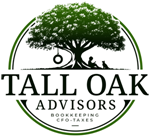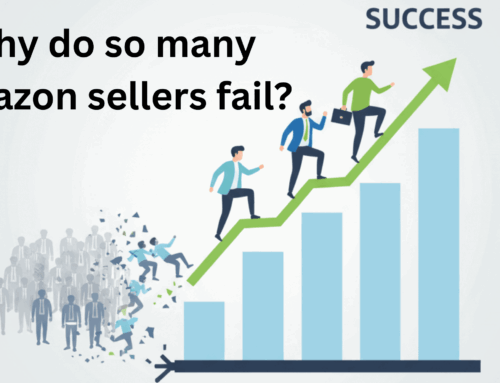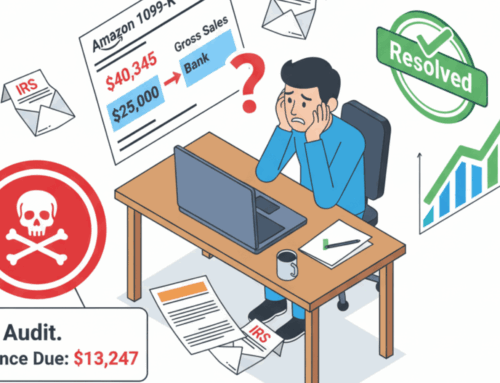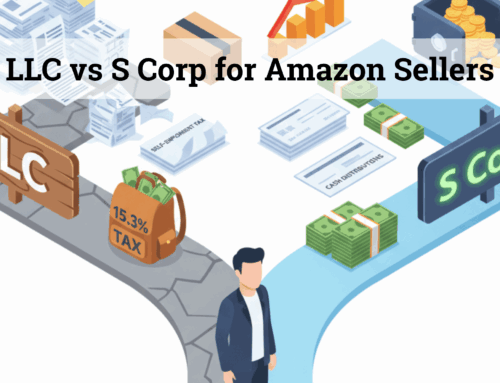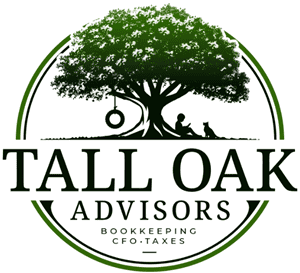If you don’t know your true costs, you’re not running a business — you’re gambling.
key points
I still remember my living room back in 2014. The carpet was covered in boxes. My old laptop sat on the coffee table with spreadsheets open. That was my “warehouse” and “office.” Every box I taped shut felt heavy, not just with products—but with hope. Back then, this wasn’t a side project. It was survival.
Every dollar mattered. Every mistake hurt. I wasn’t just learning Amazon—I was learning how to run a business from nothing. And let me tell you, the lessons I picked up back then are the same ones that keep me profitable today.

Lesson 1: Watch Your Costs Like a Hawk
I’ll never forget the first time I sold a bunch of products in one day. I was excited—until I checked the numbers. Over 60% revenue disappeared into the cost of buying the products.
It felt like running on a treadmill. Lots of effort, but no real movement.
So, I learned to negotiate harder with suppliers. Even a few cents off per unit added up. I started buying more of the fast-moving products in bulk—but only the ones I knew would sell quickly so I didn’t drown in storage fees. Every quarter, I’d sit down and check costs again, making sure they weren’t creeping up.
The habit of trying to improve my costs of goods was one of the best lessons I learned. Because every single time I was able to land a better buy cost, it added extra margin to the business. Without me doing anything else.
On Amazon, the seller with the lowest buy cost wins. When others race to the bottom on price, you can still stay profitable because your cost gives you the edge.


Lesson 2: Amazon Fees Can Sneak Up On You
When I started, Amazon’s fees were about 20% of my sales. That felt fine. But as the years have gone by, they are now closer to 30–33%.
One thing is certain as an Amazon seller. They will increase fees and find new ways to add to them.
The problem? Those fees are quiet. They don’t shout. They just slowly eat your profit. It’s like death by 1000 paper cuts.
Every product you prep. Every shipment into Amazon. Every monthly storage fee. Disposals, removals and returns.
They all add up and if you’re not careful they leave you with a credit card bill you can’t pay at the end of the month.
I had to get smart. I picked products that were small and light, so shipping costs stayed low. Products that don’t expire. And products that don’t easily break during shipping.
I made sure items didn’t sit in storage too long, because storage fees stack up fast. But at least if they do sit in storage, they take up such a small amount of space it doesn’t kill my margins.
I learned to look past sales numbers and ask: “What’s left after Amazon takes its cut?”
That question saved me from chasing products that looked good but lost money in the end.
Lesson 3: Keep Expenses Tight
In the early days, my expenses never went over 4% of sales. Why? Because I couldn’t afford waste.
No fancy tools. No big ad spend. Just the essentials. And honestly? That discipline is what kept me alive.
I capped software costs at $500 a month and only paid for tools that made a real difference. QuickBooks for accounting. SellerBoard for profit tracking. Keepa for sourcing analysis. And SellerAmp for additional sourcing and pricing support. That was it.
I also stayed debt-free. If I couldn’t buy it with cash, I didn’t buy it. That rule kept me safe from high-interest payments that could have crushed my business.
Over the years I’ve met a lot of people who take on unnecessary debt before they actually know what’s happening in their business.
First thing you need to do before using credit cards, is make sure you actually know whether or not you’re making money.
If you’re unsure, it’s a good way to end up with a bunch of inventory that’s sitting in Amazon and making it impossible for you to pay your credit card.
The interest will eat up any small profits you might have if you’re not on top of this.


Lesson 4: Scale Slow, Scale Smart
A lot of people think you need big money and big teams to scale. I didn’t.
I hit $100K a month in revenue while keeping expenses lean. I didn’t hire a team right away. Instead, I used freelancers for small tasks when I needed extra hands. My tech stack stayed simple, too.
Scaling wasn’t about growing fast—it was about staying profitable at every stage.
Profit is what’s needed to fuel growth.
Far too many people try to outsource their business before they even know whether they’re making money or not.
As with any business, you need to know how it works. You need to know how it functions and where the obstacles are.
Amazon provides a ton of leverage for you, but if you don’t know your numbers you’ll end up losing any profits to a team who can’t fully understand how to help you grow.
Even if it means less revenues, you stay more profitable by keeping a sharp eye on every single dollar your company is generating. More importantly, where the money is going.
Lesson 5: Don’t Overlook “Other Income”
This one surprised me the most. In 2014, about 13% of my profit came from “other income.” Stuff like cashback rewards, small incentives, and bonuses from using the right credit cards.
It sounds small, but over time, it adds up. That extra income helped cover little costs and even funded new inventory.
The lesson? Don’t ignore the small streams. They can make a big impact.

Final Thoughts
Building an Amazon business isn’t about chasing every hack or tool. It’s about controlling what you can. Your costs, your fees, your expenses, and finding every way to add profit to the bottom line.
I didn’t learn these lessons from a course. I learned them sitting on the floor, surrounded by boxes, trying to make it work. And they still guide me today.
If you take anything from my story, let it be this: You don’t need to do everything. You just need to do the right things—consistently.
Ready to stop guessing at your numbers? Whether you’re ready for a full-time bookkeeper or just need help setting up the right system, we’ll get your books organized, your tools in place, and a clear process you can follow. That way, you’ll finally see your true profitability after every Amazon fee and expense.

Take Control of Your Finances Today!
Whether you’re a Reseller (Wholesale, Retail Arbitrage, Online Arbitrage, Dropshipping) or a Brand Owner, managing finances is key to your success. We support eCommerce businesses across major platforms like Amazon, Shopify, eBay, Walmart, Etsy, BigCommerce, and beyond.
See if you qualify for a free strategy session with our team to learn how Tall Oak Advisors can streamline your bookkeeping and ensure accurate tax preparation for your business.
Need a quick quote?
Or explore our range of free resources crafted specifically for eCommerce sellers:
- Business Tax Worksheet
- Frequently Asked Questions About Taxes and Bookkeeping
- Tax Write-Offs Every Amazon and Shopify Seller Should Know
Take the first step toward a stronger financial future and position your business for long-term success.
If you don’t know your true costs, you’re not running a business — you’re gambling.
key points
I still remember my living room back in 2014. The carpet was covered in boxes. My old laptop sat on the coffee table with spreadsheets open. That was my “warehouse” and “office.” Every box I taped shut felt heavy, not just with products—but with hope. Back then, this wasn’t a side project. It was survival.
Every dollar mattered. Every mistake hurt. I wasn’t just learning Amazon—I was learning how to run a business from nothing. And let me tell you, the lessons I picked up back then are the same ones that keep me profitable today.

Lesson 1: Watch Your Costs Like a Hawk
I’ll never forget the first time I sold a bunch of products in one day. I was excited—until I checked the numbers. Over 60% revenue disappeared into the cost of buying the products.
It felt like running on a treadmill. Lots of effort, but no real movement.
So, I learned to negotiate harder with suppliers. Even a few cents off per unit added up. I started buying more of the fast-moving products in bulk—but only the ones I knew would sell quickly so I didn’t drown in storage fees. Every quarter, I’d sit down and check costs again, making sure they weren’t creeping up.
The habit of trying to improve my costs of goods was one of the best lessons I learned. Because every single time I was able to land a better buy cost, it added extra margin to the business. Without me doing anything else.
On Amazon, the seller with the lowest buy cost wins. When others race to the bottom on price, you can still stay profitable because your cost gives you the edge.


Lesson 2: Amazon Fees Can Sneak Up On You
When I started, Amazon’s fees were about 20% of my sales. That felt fine. But as the years have gone by, they are now closer to 30–33%.
One thing is certain as an Amazon seller. They will increase fees and find new ways to add to them.
The problem? Those fees are quiet. They don’t shout. They just slowly eat your profit. It’s like death by 1000 paper cuts.
Every product you prep. Every shipment into Amazon. Every monthly storage fee. Disposals, removals and returns.
They all add up and if you’re not careful they leave you with a credit card bill you can’t pay at the end of the month.
I had to get smart. I picked products that were small and light, so shipping costs stayed low. Products that don’t expire. And products that don’t easily break during shipping.
I made sure items didn’t sit in storage too long, because storage fees stack up fast. But at least if they do sit in storage, they take up such a small amount of space it doesn’t kill my margins.
I learned to look past sales numbers and ask: “What’s left after Amazon takes its cut?”
That question saved me from chasing products that looked good but lost money in the end.
Lesson 3: Keep Expenses Tight
In the early days, my expenses never went over 4% of sales. Why? Because I couldn’t afford waste.
No fancy tools. No big ad spend. Just the essentials. And honestly? That discipline is what kept me alive.
I capped software costs at $500 a month and only paid for tools that made a real difference. QuickBooks for accounting. SellerBoard for profit tracking. Keepa for sourcing analysis. And SellerAmp for additional sourcing and pricing support. That was it.
I also stayed debt-free. If I couldn’t buy it with cash, I didn’t buy it. That rule kept me safe from high-interest payments that could have crushed my business.
Over the years I’ve met a lot of people who take on unnecessary debt before they actually know what’s happening in their business.
First thing you need to do before using credit cards, is make sure you actually know whether or not you’re making money.
If you’re unsure, it’s a good way to end up with a bunch of inventory that’s sitting in Amazon and making it impossible for you to pay your credit card.
The interest will eat up any small profits you might have if you’re not on top of this.


Lesson 4: Scale Slow, Scale Smart
A lot of people think you need big money and big teams to scale. I didn’t.
I hit $100K a month in revenue while keeping expenses lean. I didn’t hire a team right away. Instead, I used freelancers for small tasks when I needed extra hands. My tech stack stayed simple, too.
Scaling wasn’t about growing fast—it was about staying profitable at every stage.
Profit is what’s needed to fuel growth.
Far too many people try to outsource their business before they even know whether they’re making money or not.
As with any business, you need to know how it works. You need to know how it functions and where the obstacles are.
Amazon provides a ton of leverage for you, but if you don’t know your numbers you’ll end up losing any profits to a team who can’t fully understand how to help you grow.
Even if it means less revenues, you stay more profitable by keeping a sharp eye on every single dollar your company is generating. More importantly, where the money is going.
Lesson 5: Don’t Overlook “Other Income”
This one surprised me the most. In 2014, about 13% of my profit came from “other income.” Stuff like cashback rewards, small incentives, and bonuses from using the right credit cards.
It sounds small, but over time, it adds up. That extra income helped cover little costs and even funded new inventory.
The lesson? Don’t ignore the small streams. They can make a big impact.

Final Thoughts
Building an Amazon business isn’t about chasing every hack or tool. It’s about controlling what you can. Your costs, your fees, your expenses, and finding every way to add profit to the bottom line.
I didn’t learn these lessons from a course. I learned them sitting on the floor, surrounded by boxes, trying to make it work. And they still guide me today.
If you take anything from my story, let it be this: You don’t need to do everything. You just need to do the right things—consistently.
Ready to stop guessing at your numbers? Whether you’re ready for a full-time bookkeeper or just need help setting up the right system, we’ll get your books organized, your tools in place, and a clear process you can follow. That way, you’ll finally see your true profitability after every Amazon fee and expense.

Take Control of Your Finances Today!
Whether you’re a Reseller (Wholesale, Retail Arbitrage, Online Arbitrage, Dropshipping) or a Brand Owner, managing finances is key to your success. We support eCommerce businesses across major platforms like Amazon, Shopify, eBay, Walmart, Etsy, BigCommerce, and beyond.
See if you qualify for a free strategy session with our team to learn how Tall Oak Advisors can streamline your bookkeeping and ensure accurate tax preparation for your business.
Need a quick quote?
Or explore our range of free resources crafted specifically for eCommerce sellers:
- 7 Profit Crushing Mistakes That Will Destroy Your eCommerce Business
- Business Tax Worksheet
- Frequently Asked Questions About Taxes and Bookkeeping
- Tax Write-Offs Every Amazon and Shopify Seller Should Know
Take the first step toward a stronger financial future and position your business for long-term success.
